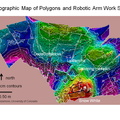
WIKIARCHIVES.SPACE
The Human Spaceflight Archive

The Thermal and Electrical Conductivity Probe on NASA's Phoenix Mars Lander detected small and variable amounts of water in the Martian soil.
Information
- Taken in
- Author
- NASA/JPL/University of Arizona
- Description
-
The Thermal and Electrical Conductivity Probe on NASA's Phoenix Mars Lander detected small and variable amounts of water in the Martian soil.
In this schematic illustration, water molecules are represented in red and white; soil minerals are represented in green and blue. The water, neither liquid, vapor, nor solid, adheres in very thin films of molecules to the surfaces of soil minerals. The left half illustrates an interpretation of less water being adsorbed onto the soil-particle surface during a period when the tilt, or obliquity, of Mars' rotation axis is small, as it is in the present. The right half illustrates a thicker film of water during a time when the obliquity is greater, as it is during cycles on time scales of hundreds of thousands of years. As the humidity of the atmosphere increases, more water accumulates on mineral surfaces. Thicker films behave increasingly like liquid water.
The Phoenix Mission is led by the University of Arizona, Tucson, on behalf of NASA. Project management of the mission is by NASA's Jet Propulsion Laboratory, Pasadena, Calif. Spacecraft development is by Lockheed Martin Space Systems, Denver.
Photojournal Note: As planned, the Phoenix lander, which landed May 25, 2008 23:53 UTC, ended communications in November 2008, about six months after landing, when its solar panels ceased operating in the dark Martian winter.
- Created on
- Monday 15 December 2008
- Albums
- US SPACE PROGRAM / PROBES / MARS / PHOENIX / Annoted/Science
- Source link
- https://photojournal.jpl.nasa.gov
- Visits
- 26
- Rating score
- no rate
- Rate this photo
- License
- Public Domain
- Modified by WikiArchives
- No (original)
- Downloads
- 1
Powered by Piwigo










